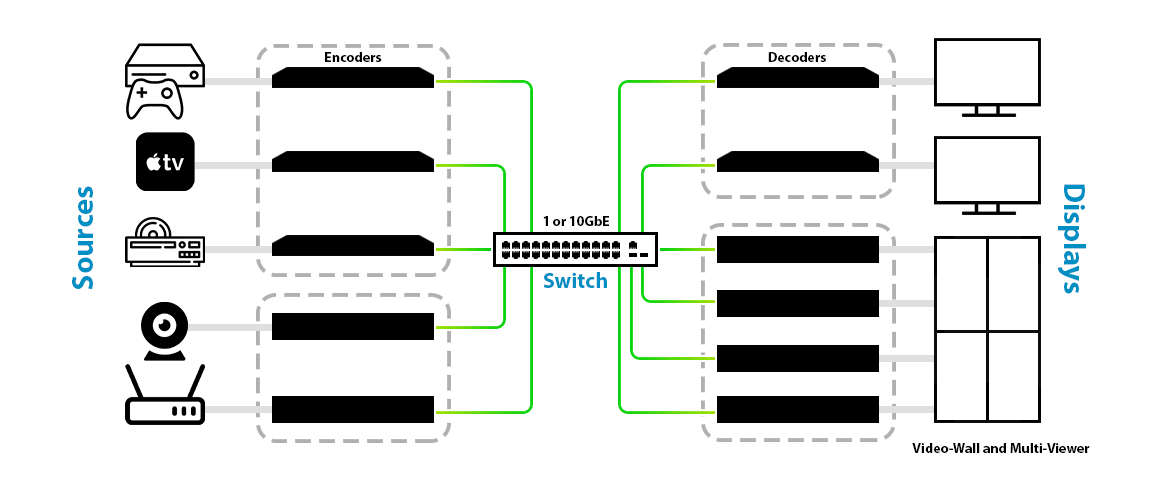AV over IP (AVoIP) is a method of distributing audio, video, control signals and more over standard IP Networks utilizing a variety of compression technologies to encode and decode transmissions between source and display depending on network demands and desired image quality.
AVoIP was initially used in a variety of ProAV applications due to its low bandwidth characteristics, compatibility with existing network infrastructures and cost-efficient scalability for large footprint arrays. However, AVoIP technology has evolved to include low and zero latency transmissions, seamless switching and lossless video quality supporting 4K UHD, high frame rates, 4:4:4 and HDR to become an increasingly viable alternative to conventional AV transmission over distance technologies for both residential and commercial applications.
 IP multicasting is a broadcast method that is utilized in certain Ethernet switches that allows a subscribed group of encoders to receive multicast data. Even though various manufacturers will employ various technology to distribute multimedia data over IP, most AV over IP products will utilize IP multicasting for audio and video communication over an IP infrastructure. IP multicasting can facilitate a ‘one to many’ or ‘many to many’ communication structure. Multicasting is also widely considered to be very efficient over an IP network as it only requires the source to send a packet only once, then the network switch will take care of duplicating the packet to reach multiple decoders so that data is sent over each link of the network only once.
IP multicasting is a broadcast method that is utilized in certain Ethernet switches that allows a subscribed group of encoders to receive multicast data. Even though various manufacturers will employ various technology to distribute multimedia data over IP, most AV over IP products will utilize IP multicasting for audio and video communication over an IP infrastructure. IP multicasting can facilitate a ‘one to many’ or ‘many to many’ communication structure. Multicasting is also widely considered to be very efficient over an IP network as it only requires the source to send a packet only once, then the network switch will take care of duplicating the packet to reach multiple decoders so that data is sent over each link of the network only once.Video over IP is a widely used method of delivering video content to an audience over a local or wide area network using Encoders and Decoders where media inputs are deconstructed into different streams and then sent over an IP network as individual data packets. Meaning users can watch real-time video and audio content, similar to watching a television broadcast. In the context of media production networks, video over IP can be perceived as a newer alternative to SDI broadcasting which has been a standard for many years.
• Perfect for decentralized system designs
• Cost scales in-line to Inputs/Outputs
• Utilizes tried and tested industry network standards to distribute content cost efficiently and reliably over IP Networks with PoE support
• Connect a display device to any room Network port and the video will automatically be routed to it
• Overcome distance limitations by utilizing optical fiber network links
• Dynamic AV routing without the need for additional distribution amplifiers or multiple transmitters at a back-end patch panel.
• Ideal for projects 16x16 and over, AVoIP is capable of the largest AV distribution spanning multiple floors or buildings
• AV distribution is now as flexible as your network
• True convergence of AVoIP and other IT services reduces hardware and installation costs when compared to non-IP AV
• Far greater flexibility than fixed port matrix solutions for large-scale installations perfectly tailored to applications
• Encoders and Decoders (1G or 10G depending on application need)
• Controller/ control system (required in some instances)
• Managed network switcher (1G or 10G depending on application need)
• Cables (Cat, HDMI, VGA, DP, USB, RS232, IR or Fiber depending on application need)
• Video sources and displays

-

Corporate -

Education -

Residential -

Healthcare -

Government
-

RTOC -

Hospitality -

Retail -

Venues -

eSports
-

Conference Rooms -

Classrooms -

Broadcast Studios -

Medical Imaging -

Retail Digital Signage
 Cat (Cat5, Cat5e, Cat6a)
Cat (Cat5, Cat5e, Cat6a)• Transmission up to 100M (328ft)
• Less expensive
• Easy to terminate
• Susceptible to artifacts (inductance/capacitance)
| Category | Shielding | Max Transmission Speed (100m) | Max Bandwidth |
|---|---|---|---|
| Cat 5 | Unshielded | 10/100 Mbps | 100 MHz |
| Cat 5e | Unshielded | 1,000 Mbps/1 Gbps | 100 MHz |
| Cat 6 | Shielded or Unshielded | 1,000 Mbps/1 Gbps | 250 MHz |
| Cat 6a | Shielded | 10,000 Mbps/10 Gbps | 500 MHz |
| Cat 7 | Shielded | 10,000 Mbps/10 Gbps | 600 MHz |
| Cat 7a | Shielded | 10,000 Mbps/10 Gbps | 1,000 MHz |
1G AVoIP systems
• Cat 5e or higher
10G AVoIP systems

• Cat 6a or higher
Fiber (SFP 1G/SFP+ Multimode550M or Singlemode10-20KM)
• Miles of transmission
• More expensive (but very close)
• Immune to artifacts
• Higher data rates
• More difficult to terminate
| Traditional AV Examples | AV over IP Examples |
|---|---|
| 1. Digital video Tx and Rx boxes and/or cables Digital video matrix switcher HDMI DisplayPort SDI HDBaseT |
1. Standards-based AV-over-IP products SMPTE 2110 specification for uncompressed video over IP JPEG-2000 lightly compressed video over IP H.264 high-efficiency compression over IP |
2. Analog video Tx and Rx boxes and/or cables Analog video matrix switcher Composite video S-Video Component video |
2. Proprietary AV-over-IP products The packets between encoders and decoders respect Internet Protocol and the streams can be switched on standard IP switches, but the encoding scheme (packetization of video) is proprietary and incompatible with any devices using standards-based codecs. Example: SDVoE |
IGMP Snooping
IGMP snooping is the process of listening to Internet Group Management Protocol (IGMP) network traffic to control delivery of IP multicasts. Network switches with IGMP snooping listen in on the IGMP conversation between hosts and routers and maintain a map of which links need which IP multicast transmission. Multicasts may be filtered from the links which do not need them, conserving bandwidth on those links.
Jumbo Frames
Jumbo frames were introduced to help improve the overall performance of Ethernet networks using gigabit and faster Ethernet networks. Each frame that a switch has to process uses resources on the switch. As video tends to have more ‘data’ than other communications types, a delivery mechanism that is more efficient is necessary. Enabling jumbo frames, increases the frame size, reducing the number of frames the switch needs to process and reduces the overhead and CPU cycles needed on the switch
Unicast refers to a one-to-one transmission from one point in the network to another point; that is, one sender and one receiver, each identified by a network address.
Broadcasting is a method of transferring a message to all recipients simultaneously. Broadcasting can be performed as a high level operation in a program, for example broadcasting in Message Passing Interface, or it may be a low level networking operation, for example broadcasting on Ethernet.
Multicast is group communication where data transmission is addressed to a group of destination computers simultaneously. Multicast can be one-to-many or many-to-many distribution.
Anycast is a network addressing and routing methodology in which a single destination address has multiple routing paths to two or more endpoint destinations. Routers will select the desired path on the basis of number of hops, distance, lowest cost, latency measurements or based on the least congested route. Anycast networks are widely used for content delivery network (CDN) products to bring their content closer to the end user.
A: AV over IP stands for “Audio-Visual over Internet Protocol”. ... As opposed to traditional AV environments, AV over IP (also known as AV/IP) refers to the use of standard network equipment to transmit and switch video and audio.
Q: What Is Video over IP and How Does It Work?
A: Video over IP is a widely used method of delivering video content to an audience over a local or wide area network where media inputs are deconstructed into different streams and then sent over an IP network as individual data packets.
Q: What is AV in networking?
A: AV over IP stands for “Audio-Visual over Internet Protocol”. Essentially, it is the transmission of audio-visual data over a network such as a LAN, WAN, or the internet.
Q: What is an IP stream?
A: IP streaming. IP-based streaming systems are capable of broadcasting video content for a large number of online viewers, whether it be a live broadcast or an on-demand canned material. ... Overall, streaming service requires complex integration of multiple components that requires audio-video devices and IT infrastructure.
Q: How is video transmitted over Internet?
A: This is possible because of a technology called streaming. Streaming is the continuous transmission of audio or video files from a server to a client. ... With streaming, the media file being played on the client device is stored remotely, and is transmitted a few seconds at a time over the Internet.
Q: Do I need a 10G switch for my 1G AVoIP encoders and decoders?
A: Not necessarily, 1G encoders and decoders will work fine on a 1G network switch because it requires less bandwidth opposed to 10G encoders and decoders which require more bandwidth.
Q: Do I need a managed network switch to use AVoIP products?
A: Yes, a managed network switch is require to be able to make the necessary switch configurations to allow AVoIP products on a network.
Q: What is the maximum distance can I go with AVoIP?
A: AVoIP will allow you to go further distances that traditional AV extenders cannot go, you would have to add more network switches between each end points (encoders & decoders) if you want to go beyond 330ft or you can use fiber cables to go long distances depending on your application.
Q: Can AVoIP be controlled?
A: Yes, AVoIP can be controlled by its own control software, Apps and by 3rd party control systems provided by the API or control drivers.
Q: Do I need a 6x6 matrix switcher to use with my AVoIP encoders and decoder?
A: No matrix switcher is required when it comes on to AVoIP, all you know is 6 encoders, 6 decoders and a network switch along with the control software or App to deploy the encoders and decoders as a matrix switcher.
Q: Can I use a cat5e cables with AVoIP?
A: Cat5e cabling will work but using a cat6 or cat6A is recommended in the deployment of AVoIP for optimal performance on a network.
Q: What is the purpose of an AVoIP controller?
A: An AVoIP controller plays the main role of discovering all encoders and decoders on a network which then gives users the ability to configure and control each encoder and decoder, think of the controller as the central point of control.
Q: How many decoders would I need to create a 6x6 video-wall?
A: You would need 36 decoders along 36 display and 36 available ports on your network switch.
Q: Can I use 1G AVoIP products from 2 different companies and they work together?
A: No, currently in the AV market there are no 1G AVoIP products from 2 different companies that will work together. The only AVoIP hardware at this moment that are capable of coming from two different companies and work together are SDVoE 10G products.
Q: Does it matter what brand network switch I have to use AVoIP products?
A: Not necessarily, while in general AVoIP products should work with any brand managed network switch many manufacturers and companies may provide a list of recommended network switches that they have tested their products with and will guarantee it will work. However if you have a different switch that is not on that list you should contact your switch manufacture and ask for guidance on how to enable the necessary settings such as IGMP snooping, Jumbo frames and multicasting to get your AVoIP hardware working.
Q: What AVoIP extenders would offer minimal latency?
A: Using a 10G extender such as SDVoE will offer zero latency on a 10G network.
Q: What are some ideal spaces to use 1G vs 10G AVoIP hardware?
A: 1G - Typical classroom, boardroom, meeting room, video conferencing, digital signage. 10G - Auditorium, Lecture hall, live concert venues, Arenas, Command & Control centers, eSports, medical imaging.
Q: Is there an AVoIP industry standard?
A: There is a proposed standard called SMPTE 2110 by aims alliance that is not adopted in the AV industry today, only if the industry AVoIP leaders adopt this standard then it may be widely adopted.
Q: What are the main differences between an HDBaseT and video over IP solutions?
A: HDBaseT will max out at 100m, whereas the flexibility of a network-based systems can go further distances by stacking switches which can be distributed up to 10km if needed.
Q: Can I transmit control signals over IP?
A: Yes you can transmit control signals such as IR, RS232 and USB over IP.
Q: How can I power AVoIP encoders and decoders in hard remote places where there is no AC power outlet?
A: If your network switch and encoders and decoders supports PoE, the network switch will power the encoders and decoders in remote areas over the cat cabling where there is no AC power outlet.






